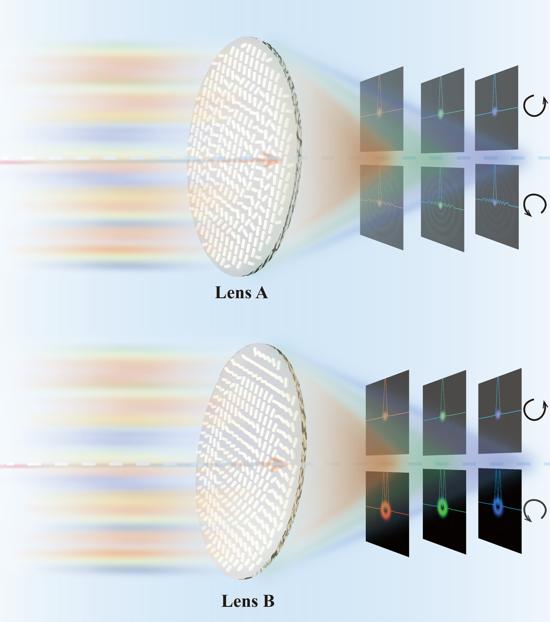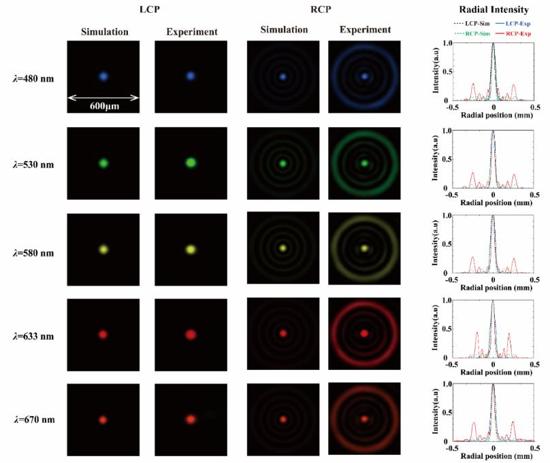Arbitrary manipulation of multi-dimensional optical field is a development tendency of advanced optical system. Conventional optical elements achieve the specific optical functions based on the gradual phase changes accumulated along the propagation path, which leads to the shortcomings of low degree freedom, large device size, and single functionality, etc. To satisfy the urgent requirements of the high-integrity and lightweight optical system, planar optics components based on geometric phase have become a hot research topic in recent years.
Geometric phase metasurfaces can flexibly manipulate the phase by rotating the angle of the anisotropic structure, which have been widely used in optical lenses , catenary optics, the spin Hall effect, holograms, vortex beam generators, and so on. However, traditional metasurfaces based on the geometric phase have the conjugate symmetry limitation in the process of photon spin-orbit interaction, that is, the geometric phase produced by the LCP and RCP are opposite, which is difficult to achieve multifunctional multiplexing. Therefore, the geometric phase metasurfaces suffer from the single functionality since only single chiral polarization can be realized for focusing and imaging.
To address the above issue, the researchers from the Institute of Optics and Electronics proposed the broadband high-efficiency polymerized liquid crystal (LC) metasurfaces for the chiral multifunctional focusing based on wavefront engineering and holographic synthesis, which helps to improve the flexibility and compactness in modern advanced imaging systems. The related results are published in Photonics Research Vol. 10, Issue 6 (Xinjian Lu, Xiaoyin Li, Yinghui Guo, Mingbo Pu, Jiangyu Wang, Yaxin Zhang, Xiong Li, Xiaoliang Ma, and Xiangang Luo, Broadband high-efficiency polymerized liquid crystal metasurfaces with spin-multiplexed functionalities in the visible [J]. Photonics Research, 2022, 10(6): 1380-1393).
Two different spin-multiplexed LC metasurfaces are designed. As shown in Fig. 1, device A realizes the diffraction-limited focusing and sub-diffraction focusing with 0.8 times Abbe diffraction limit under opposite handednesses, which is implemented by imparting the focusing phase and super-oscillatory phase on the opposite chiral circular polarized light respectively.

Fig.1 Schematic diagram of broadband high-efficiency polymerized LC metasurfaces. The first row indicates that the designed device A can enable polarization-switching functions from diffraction-limited focusing to sub-diffraction focusing, and the second row indicates that the designed device B can achieve the polarization-switching behavior from diffraction-limited focusing to focusing vortex beam.
Similarly, by adding the focusing phase and vortex focusing phase on the opposite chiral circularly polarized light respectively, device B realizes the polarization-switchable functionalities from high-resolution optical imaging to edge detection imaging. Benefiting from the high polarization conversion rate of LC and the inherent broadband characteristics of geometric phase, the proposed LC metasurfaces achieve broadband characteristics in the visible band.
The results presented in Fig. 2 confirm that the experimental results are consistent with the simulation results. The LC metasurfaces with large-area nanofabrication and planar high-efficiency provides a promising route towards planar photonics.

Fig.2 Simulated and experimental light distributions at the focal plane for device A under the incident light with different polarizations and wavelengths. The width and length of the figures in simulated and experimental results are all fixed as 600 μm.
In this work, the authors propose a broadband high-efficiency polarization-multiplexing method to yield the switchable functionalities in the visible. The design is mainly based on geometric phase to obtain broadband phase modulation and LCs with low loss and high polarization conversion efficiency. In terms of multi-functional device design, the switchable functions can be achieved under the different incident lights with the LCP and RCP polarized states. Generally, it combines the merits of LC devices and metasurfaces, which will have potential for future compact multi-functional micro-nano optical devices.
Currently, this group is devoting to the research on ultrathin, lightweight and high-integrated advanced optical imaging systems, polymerized LC metasurfaces provided a potential solution for the mass-scale and low-cost micro-nano fabrication. Meanwhile, the phase control resolution of LC metasurfaces is considered to be further improved to achieve the electromagnetic wavefront control at the subwavelength scale. The relevant applications based on LC metasurfaces are also under development.


